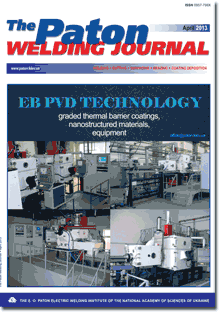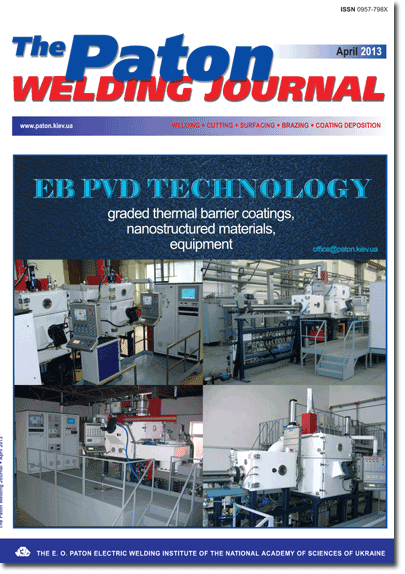| 2013 №04 (05) | 2013 №04 (07) |

The Paton Welding Journal, 2013, #4, 34-36 pages
METALLURGICAL PECULIARITIES OF PLASMA-ARC WELDING OF CHROME-BRONZE
V.M. ILYUSHENKO1, Yu.G. NOVOSELTSEV2 and S.L. BUSYGIN2
1E.O. Paton Electric Welding Institute, NASU, Kiev, Ukraine
2Siberian FederalUniversity, Krasnoyarsk, RF
Abstract
Arc welding of parts from chrome-bronze is related with weld metal susceptibility to hot cracking. Given are the results of investigations on finding the measures for prevention of formation of hot microcracks in metal of chrome-bronze BrKh08 welds of large thickness performed by plasma-arc welding. It is shown that the main reason of defect formation in the weld metal is entry of air oxygen in plasma arc that results in intensive oxidation of chromium in a weld pool and transfer of weld metal to zone of maximum brittleness of Cu-Cr alloys. Considering that one slag coverage is not enough for large volume of liquid metal pool formed in plasma-arc welding over the flux layer using powerful modes (Iw = 1000-1400 A, Ua = 48-55V) in order to obtain quality weld, additional alloying of weld metal by chromium and small additions of titanium being efficient deoxidizer is concluded to be reasonable. Special filler wire of PPBrKhT 12-2 grade was developed for this purpose. Its application in combination with selected flux allowed successfully solving the task of industrial manufacture of moulds for metallurgical electro-furnaces. 9 Ref., 5 Figures.
Keywords: chrome-bronze, plasma-arc welding, solidification, structure, cracks
Received: 13.02.13
Published: 28.04.13
References
1. Ilyushenko, V.M., Sedov, V.E., Anoshin, V.A. (1977) Improvement of technology of plasma-arc welding of parts from copper and chrome-bronze. Svarochn. Proizvodstvo, 11, 31-32.
2. Gurevich, S.M. (1981) Reference book on welding non-ferrous metals. Kiev: Naukova Dumka.
3. Novoseltsev, Yu.G. (2008) Technological peculiarities of plasma welding of large dimension structures from copper and its alloys. Krasnoyarsk: KGU.
4. Novikov, I.I. (1966) Hot brittleness of non-ferrous metals and alloys. Moscow: Nauka.
5. Ilyushenko, V.M., Anoshin, V.A., Bondarenko, A.N. et al. (1980) Study of effect of impurities and alloying elements on hot crack formation in copper welding. In: Proc. of 1st All-Union Conf. on Relevant Problems of Welding of Non-Ferrous Metals. Kiev: Naukova Dumka, 217-221.
6. Ilyushenko, V.M., Anoshin, V.A., Zherdev, A.M. et al. (1985) About effect of impurities on susceptibility to crack formation in copper welding. In: Proc. of 2nd All-Union Conf. on Relevant Problems of Welding of Non-Ferrous Metals. Kiev: Naukova Dumka, 335-337.
7. Glikman, E.E., Goryunov, Yu.V. (1978) Mechanism of liquid metal brittleness and other developments of Rehbinder effect in metallic systems. Fiz.-Khimich. Mekhanika Materialov, 4, 20-30.
8. Smiryagin, A.P. (1956) Inductrial non-ferrous metals and alloys. Moscow: Metallurgizdat.
9. Shipulin, A.P., Zobnina, G.K., Bosak, L.K. et al. (1974) Effect of titanium on weld metal plasticity in submerged arc welding of BrKh08 alloy. Svarochn. Proizvodstvo, 4, 25-27.
Suggested Citation
V.M. ILYUSHENKO1, Yu.G. NOVOSELTSEV2 and S.L. BUSYGIN2 (2013) METALLURGICAL PECULIARITIES OF PLASMA-ARC WELDING OF CHROME-BRONZE. The Paton Welding J., 04, 34-36.The cost of subscription/purchase order journals or individual articles
| Journal/Currency | Annual Set | 1 issue printed |
1 issue |
one article |
| TPWJ/USD | 384 $ | 32 $ | 26 $ | 13 $ |
| TPWJ/EUR | 348 € | 29 € | 24 € | 12 € |
| TPWJ/UAH | 7200 UAH | 600 UAH | 600 UAH | 280 UAH |
| AS/UAH | 1800 UAH | 300 UAH | 300 UAH | 150 UAH |
| AS/USD | 192 $ | 32 $ | 26 $ | 13 $ |
| AS/EUR | 180 € | 30 € | 25 € | 12 € |
| SEM/UAH | 1200 UAH | 300 UAH | 300 UAH | 150 UAH |
| SEM/USD | 128 $ | 32 $ | 26 $ | 13 $ |
| SEM/EUR | 120 € | 30 € | 25 € | 12 € |
| TDNK/UAH | 1200 UAH | 300 UAH | 300 UAH | 150 UAH |
| TDNK/USD | 128 $ | 32 $ | 26 $ | 13 $ |
| TDNK/EUR | 120 € | 30 € | 25 € | 15 € |
AS = «Automatic Welding» - 6 issues per year;
TPWJ = «PATON WELDING JOURNAL» - 12 issues per year;
SEM = «Electrometallurgy Today» - 4 issues per year;
TDNK = «Technical Diagnostics and Non-Destructive Testing» - 4 issues per year.


